December News 2023
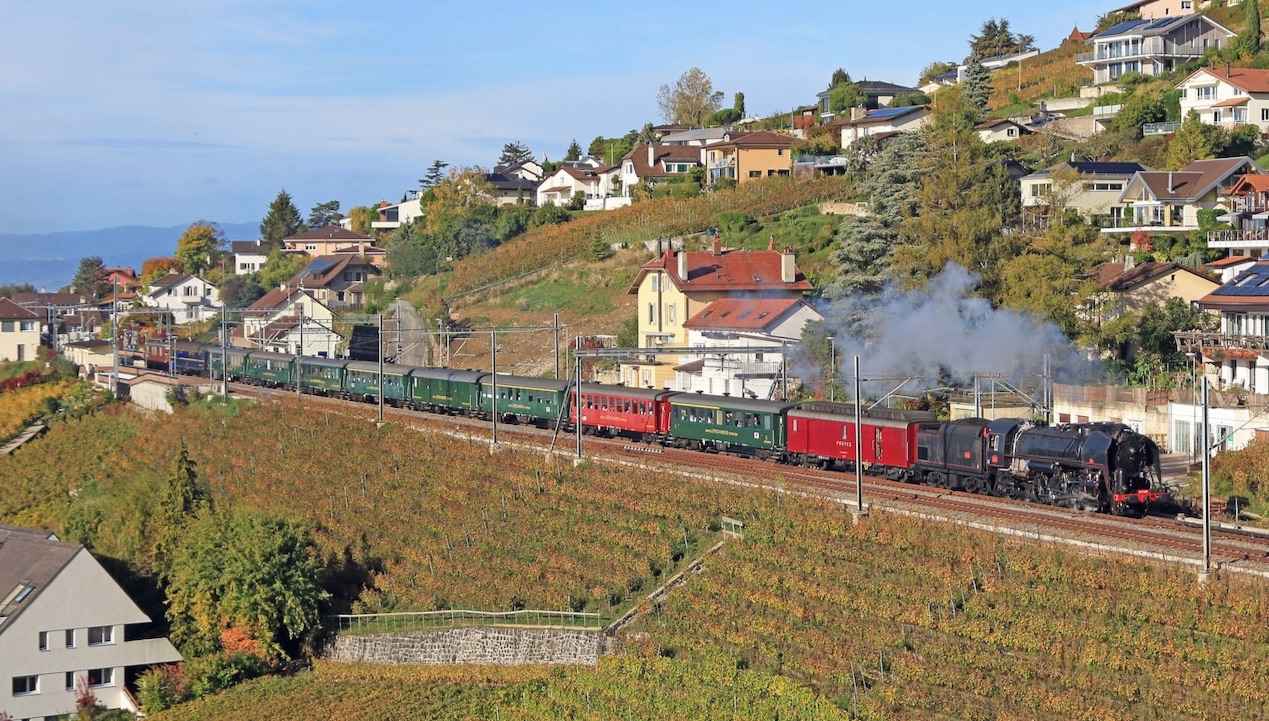
With Lake Geneva in the background, 141 R 568 is seen passing Grandvaux, east of Lausanne on the 29th October with a Swiss Classic Train special from Vallorbe to Lyss, passing through Bern on the outward journey and returning via Neuchâtel. Photo: Christophe Masse.
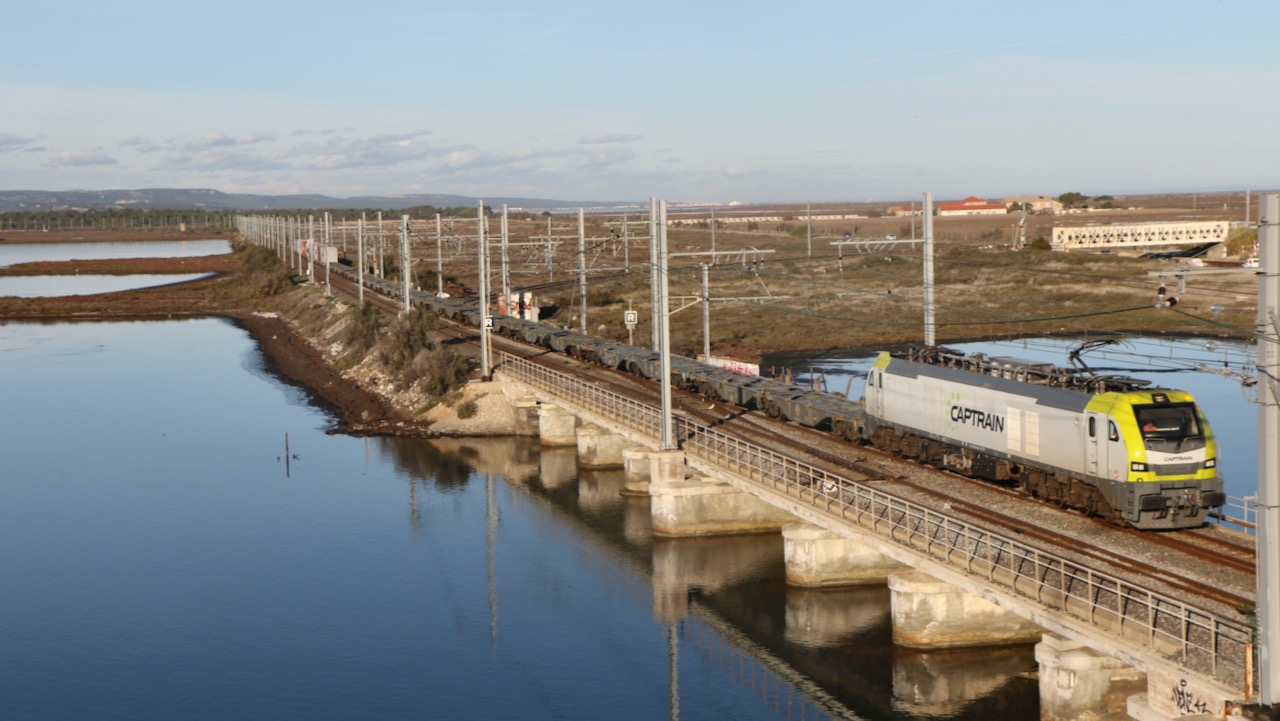
New Captrain freight flows
November saw the start of two new flows involving SNCF freight subsidiary Captrain, bringing its Stadler E6000s further into France. On 7th November a new flow started between Toulouse Saint-Jory yard and Barcelona Can Tunis using the Perthus tunnel LGV. The service is run on behalf of Chinese shipping company Hutchison with Captrain providing the locomotive that works throughout; it is operated by Naviland Cargo staff. At Saint-Jory SNCF Fret brings the train onto non-electrified tracks reserved for Naviland Cargo. E6003 is seen above on 14th November at Port-la-Nouvelle with a southbound working.
The 14th November saw the start of a second flow wholly-operated by Captrain for Maersk between Barcelona port and a terminal at Loire-sur-Rhône, just south of Lyon. The first northbound train was hauled by E6008 bearing a special Captrain livery, seen opposite at Port-la-Nouvelle crossing the channel connecting the Etangs de Bages with the sea. The Perthus high-speed concessionaire LFP Perthus has recently cut its freight track-access charges by 50% .
Photos: Georges Turpin.
The Co-Co E6000 locomotives are leased from Alpha Trains and can operate at 6,170kV under 25kV AC and 3kV DC, and 4,100kV under 1.5kV DC. They were specifically ordered by Captrain España for cross-border traffic between Spain, France, Belgium and Luxembourg, although until recently they have not normally operated north of Perpignan.
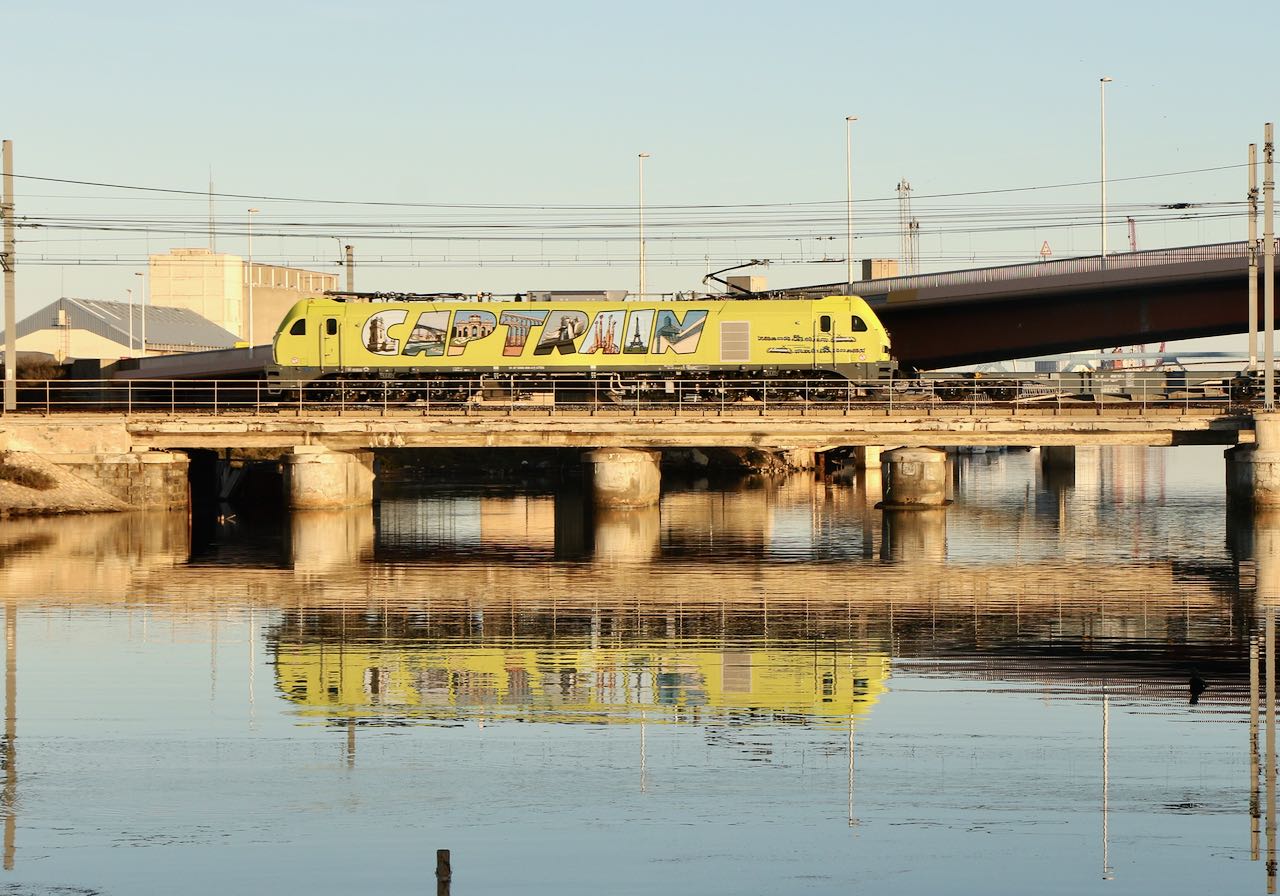
AURA announces €5.7 billion rail investment plan
Friday 20th October saw Auvergne-Rhône-Alpes région unveil a €5.7 billion rail investment plan, described as the biggest outside of Île-de-France. The investment is a response to the increased demand for rail travel, up 20% across the region since 2019, and has two objectives: to stimulate 30% growth in passenger-journeys from 220,000 to 300,000 a day; and to improve passenger comfort and train frequency with 30% more services. The plan will be delivered over the period 2024 to 2035. Improvements are also expected to come from competitive tendering, starting with Auvergne in 2028. Regional President Laurent Wauquiez stated that although he was not in favour of the process, SNCF had been given the opportunity and not delivered the improvement expected.
Cornerstone of the plan will be acquisition of 130 Regio2N EMUS. These will be delivered at roughly 10 per year over the 12-year period. It increases AURA’s investment in rolling stock to €259 million a year, compared to €72 million a year between 2010-15 and €132 million a year between 2016 and 2023. AURA TER is still reliant on a large fleet of BB 22200s based at Chambéry, hauling Corail stock on services from Lyon to Dijon and east to Savoie.
Opposite. AURA departures at Lyon Part-Dieu on 23rd May: Z 24500 three-car set No 625 (Z24749/50) waits with TER 17625 16.16 to Grenoble while another set in the background is working TER 886187 16.20 to Avignon Central.
Photo: Chris Bushell.
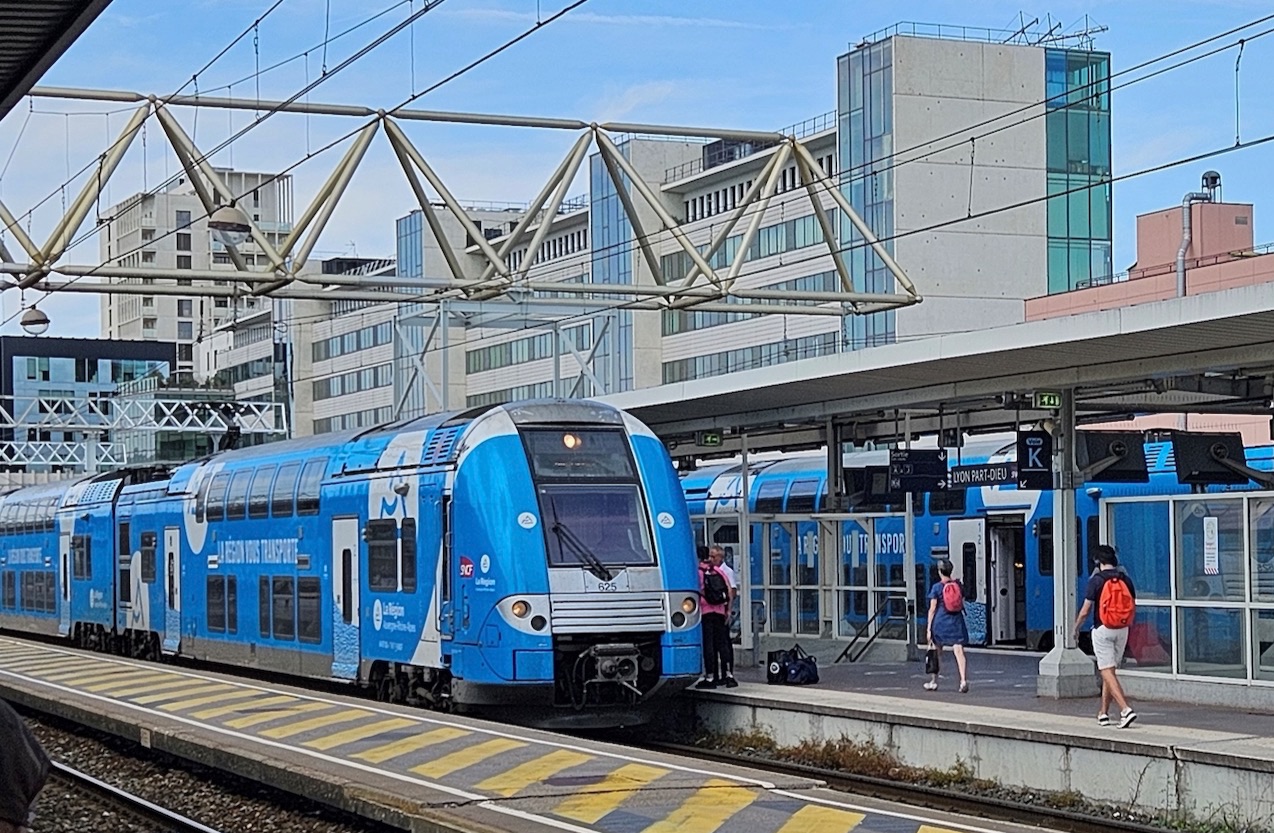
The remaining €2.7 billion will be spent on Infrastructure, with the principal objective of stopping further line closures. Although there are calls to reopen Thiers – Boën and Clermont-Ferrand – Le Mont-Dore in particular, reopenings will only take place with state intervention. However, the forthcoming CPER (State-Region Contract plan) says that the credits must not be used to finance reopening projects. Station facilities will also be improved, with secure parking for bicycles increasing from 4,000 to 10,000 places. These will be free for holders of the OURA card that will be available on mobile phones from 2026.
The plans do not include any provision for development of metropolitan RER systems, despite there being proposals for Lyon, Chambéry, Grenoble, Saint-Etienne and Clermont-Ferrand. The forthcoming CPER includes €182 million for RERs, while the région believes that it needs around €4 billion. The total being offered by the state for all forms transport in the CPER is €620 million, the région pointing out that this represents only 7% of the national envelope despite AURA having 13% of the population.
Occitanie orders more EMUs
In pursuit of its aim of carrying 100,000 daily TER passengers, Occitanie région has ordered a further 11 Regio2N EMUs from Alstom at a cost of €142 million, with seven more likely to follow next year. Entry into service in the second quarter of 2026 will bring Occitanie’s Regio2N fleet to 36.
Occitanie has achieved the biggest growth in passenger-journeys of any région according to figures for January to September published by SNCF Voyageurs on 6th November. Compared with the same period last year, all régions recorded increased TER patronage, with Occitanie 20% up, followed by PACA and Grand Est at 15%, Bretagne 12%, Pays de la Loire 11% and Nouvelle-Aquitaine 10%. Other régions recorded single-digit increases.
Opposite. Occitanie Regio 2N Set 442 Cm (Z56383/84) is seen between Muret and Portet-Saint-Simon with Train 872719 Toulouse-Matabiau – Tarbes on 28th April.
Photo: Georges Turpin.
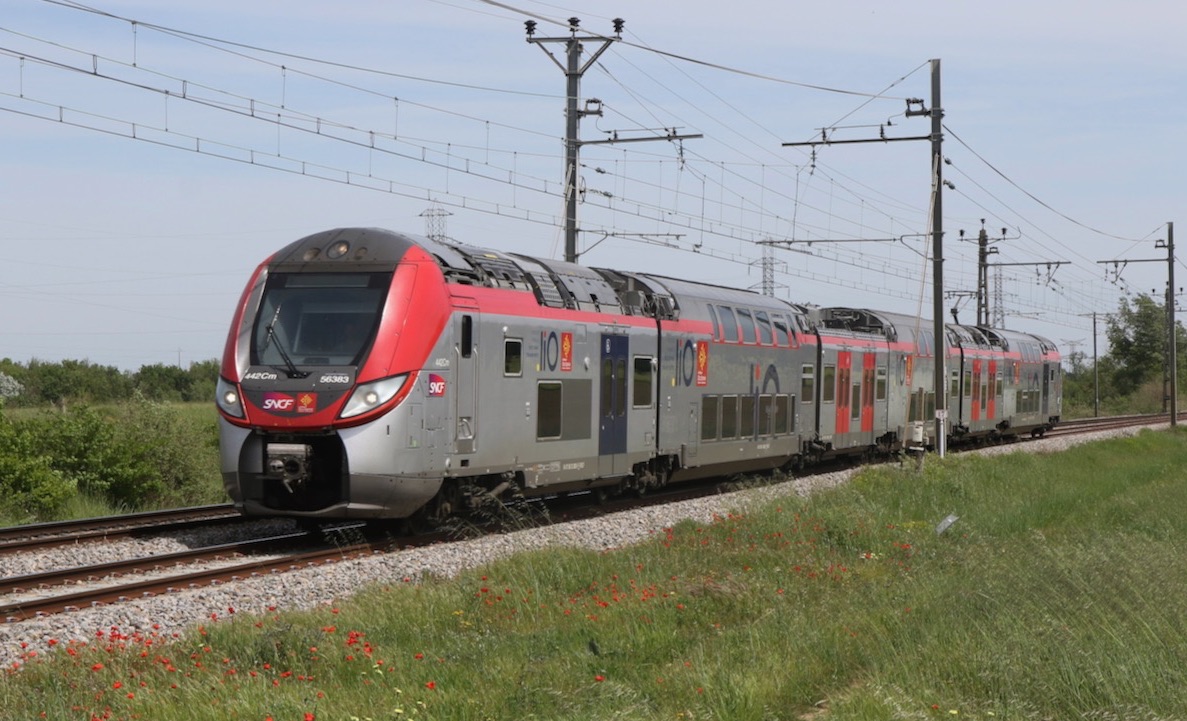
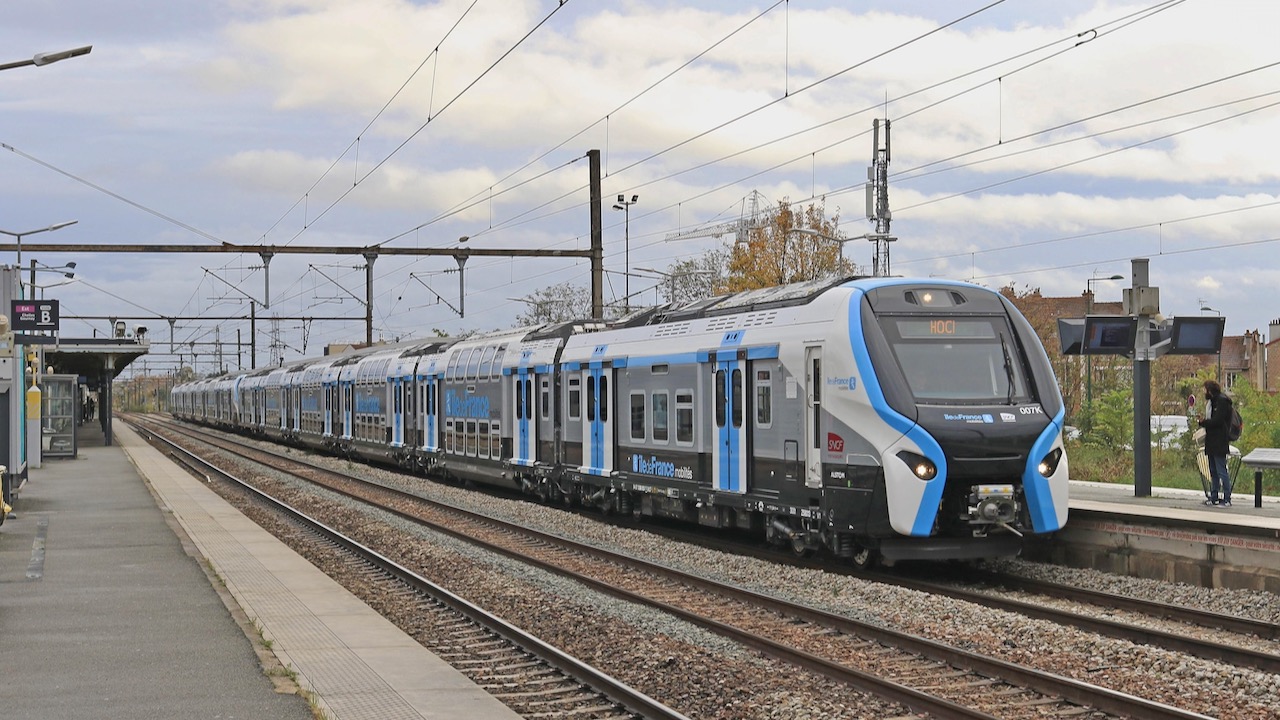
NExTEO for RER Lines B and D
Agreement has been reached for the NExTEO communications-based signalling and control system to be deployed on RER Lines B and D. Senior executives of the project partners, comprising the State, Île-de-France région, SNCF Réseau, SNCF Voyageurs and RATP, signed a protocol on 12th October agreeing finance of €967 million for the lineside equipment. This was followed on 22nd November by award to Alstom of a 12-year framework contract valued at almost €300 million for development and installation of automation equipment on 350 trainsets and around 100 route-km.
Designed for attended automatic train operation to GoA2 (Grade of Automation 2), NExTEO is currently being installed on Line E from Pantin westwards over the extension under construction between Haussmann Saint-Lazare and Nanterre, the first section of which opens in April. Its application on Lines B and D is intended to raise throughput on the joint section between Gare du Nord and Châtelet-Les Halles, already one of the world’s most heavily-used railway tunnels. Capacity will rise from the current 28 trains/h in each direction at peak times to 32 trains/h, 20 for Line B and 12 for Line D, to handle an additional 7,000 passengers/h. To achieve this, NExTEO will be installed over a wider area of both routes to optimise presentation of trains at the tunnel entrances and thus improve punctuality. Deployment in the core tunnel section is scheduled for 2031, with the outer sections following by 2033.
The new RER NG units are designed to operate with NExTEO and will take over services on Line B/D and E. At the end of November nine sets had been formally accepted by SNCF, although others have been involved in NExTEO testing since last year.
The first commercial services on Line E, using the existing legacy signalling systems, ran on 13th November between Chelles-Gournay and Haussman Saint-Lazare with two sets operating in multiple (007/008 and 013/012).
Set 007 (Z58013/14) seen above waiting to depart from Chelles-Gournay and opposite arriving at Haussmann St-Lazare with the first commercial service on 13th November. Photos : Christophe Masse.
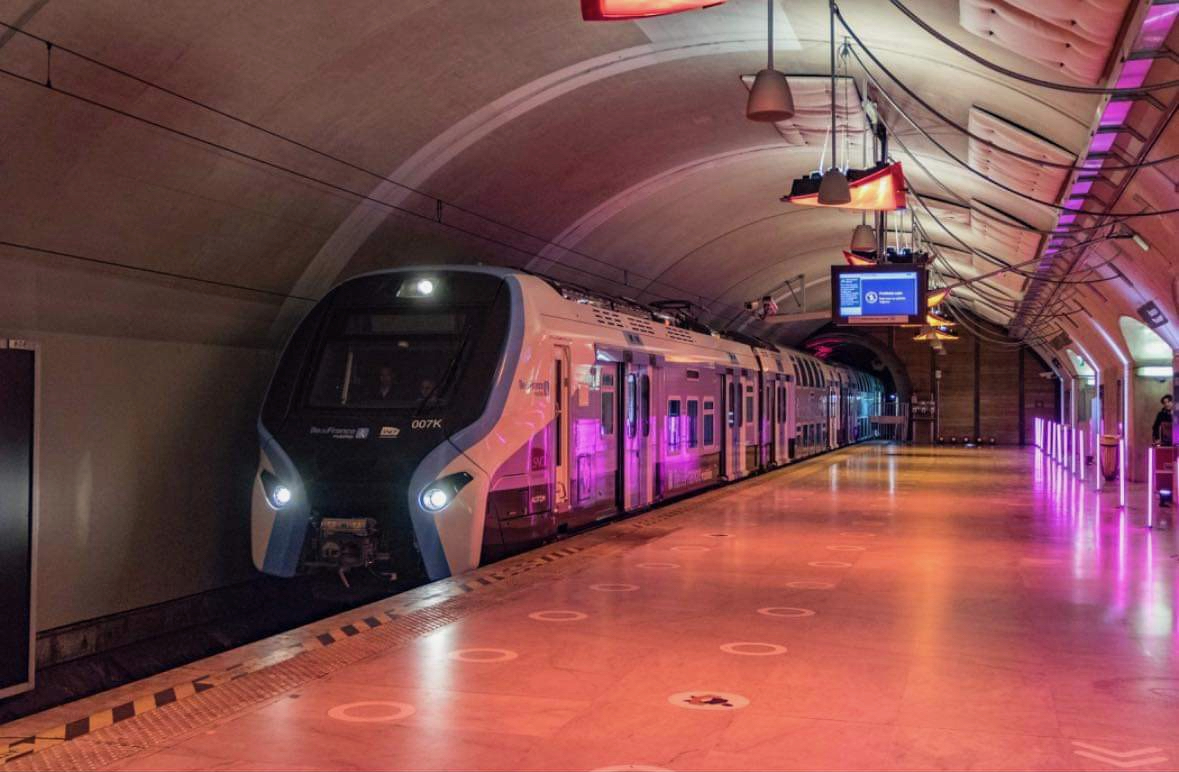
Line E future on show
Access corridors at Haussman Saint-Lazare and Magenta stations have been transformed into immersive exhibits showing the new trains, stations and colours of RER Line E, giving passengers a glimpse of the NG trains now entering service (see above) as well as Porte Maillot, La Défense-Grande Arche and Nanterre-La Folie stations on the western extension opening in April. Photo: Île-de-France Mobilitiés.
The new Porte Maillot station in October, rigid catenary installed. Photo: batiactu/JI.

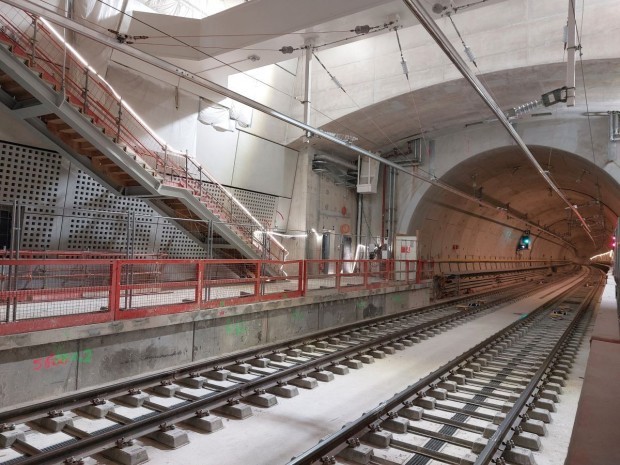
New night trains from December timetable
Paris – Berlin
In a joint collaboration with DB and ÖBB, SNCF Voyageurs will introduce a Paris – Berlin overnight service from 11th December using ÖBB Nightjet stock. A single set of stock will make three return journeys a week departing Paris Gare de l’Est for Berlin on Tuesdays, Thursdays and Saturdays and returning Berlin – Paris on Mondays, Wednesdays and Fridays. Departing from Paris at 19.12 the service will call at Strasbourg, Frankfurt, Erfurt and Halle, arriving in Berlin at 08.26, The return train will leave Berlin at 20.18 with arrival in Paris at 10.24.
The train will consist of a six-car set attached to the existing Paris – Vienna service and will be detached/attached during an unadvertised stop at Mannheim.There will be three standards of accommodation: two coaches providing seating in six-seat compartments with tickets from €29.90; two coaches offering four- and six-berth couchettes with tickets from €59.90; and two coaches with 72 sleeping berths in single, double and triple compartments, deluxe with shower and toilet, plus free drinks and breakfast, with tickets from €94.90. A second coaching set will be introduced in autumn 2024 making it a daily service. The service will initially run for three years under a public service agreement between SNCF and the Ministry of Transport, which is providing financial support for operation of the Berlin/Vienna train within France.
Paris – Aurillac
The Aurillac overnight service is introduced this month, starting with the Sunday 10th December departure from Aurillac at 22.41 arriving in Paris at 08.31. The first Paris departure is on Friday 15th leaving Austerlitz at 19.27, arriving at Aurillac at 07.30. The train calls at Saint-Denis-Près-Martel, Bretenoux-Biars and Laroquebrou in both directions. Northbound, seats are available at €22, southbound at €30. Interestingly, Aurillac can be reached at 07.16 by catching the Rodez portion of the 19.27 and changing at Figeac (depart 05.59), for which a higher fare is demanded.
Initially, the train runs weekends-only out of season and daily during school holidays, but local politicians have received an undertaking from transport minister Clément Beaune that year-round daily service will be offered in the December 2024 timetable.
Paris – Tarbes
Also in the new timetable, the Paris – Tarbes night train is diverted from its present route (POLT) to run via Bordeaux, reaching Tarbes from the west instead of the east, thus avoiding the four-tracking works north of Toulouse. The train will call at Les Aubrais, Bayonne, Orthez, Pau and Lourdes. Stops at Saint-Gaudens, Saint-Jean-de-Luz and Hendaye are replaced by TER connections. On certain dates, the southbound train runs as 3744 Paris Austerlitz depart 21.38, otherwise as 3730 departing at 22.12. Train 3730 follows the classic route, with haulage by BB 7200 locos. Train 3744 takes L’Océane LGV at Saint-Pierre-des-Corps hauled by one of the four Infra TVM-430-equipped BB 22200s(Nos 22378-380/399) and limited to 160 km/h. Arriving in Bordeaux at 01.50, the train stands until 05.15 before running forward with BB 7200 haulage. Northbound, Train 3747 departs Tarbes at 18.45 (times vary) and lays over at Bordeaux from 22.50 until departure at 02.50 via the LGV route (same itinerary as southbound). When the classic route is followed throughout, train number is 3741. With Tarbes now the starting point of this train, departure time is very much earlier than the previous 22.14. It is possible to leave Tarbes at 17.34 on TGV 8586 for a Paris arrival at 22.53, whilst a later departure by TER 872744 at 19.44 connects at Toulouse with Train 3750 (the Cerbère night train) arriving Paris Austerlitz at 07.03.
Also in the new timetable, the Paris – Tarbes night train is diverted from its present route (POLT) to run via Bordeaux, reaching Tarbes from the west instead of the east, thus avoiding the four-tracking works north of Toulouse. The train will call at Les Aubrais, Bayonne, Orthez, Pau and Lourdes. Stops at Saint-Gaudens, Saint-Jean-de-Luz and Hendaye are replaced by TER connections. On certain dates, the southbound train runs as 3744 Paris Austerlitz depart 21.38, otherwise as 3730 departing at 22.12. Train 3730 follows the classic route, with haulage by BB 7200 locos. Train 3744 takes L’Océane LGV at Saint-Pierre-des-Corps hauled by one of the four Infra TVM-430-equipped BB 22200s(Nos 22378-380/399) and limited to 160 km/h. Arriving in Bordeaux at 01.50, the train stands until 05.15 before running forward with BB 7200 haulage. Northbound, Train 3747 departs Tarbes at 18.45 (times vary) and lays over at Bordeaux from 22.50 until departure at 02.50 via the LGV route (same itinerary as southbound). When the classic route is followed throughout, train number is 3741. With Tarbes now the starting point of this train, departure time is very much earlier than the previous 22.14. It is possible to leave Tarbes at 17.34 on TGV 8586 for a Paris arrival at 22.53, whilst a later departure by TER 872744 at 19.44 connects at Toulouse with Train 3750 (the Cerbère night train) arriving Paris Austerlitz at 07.03.
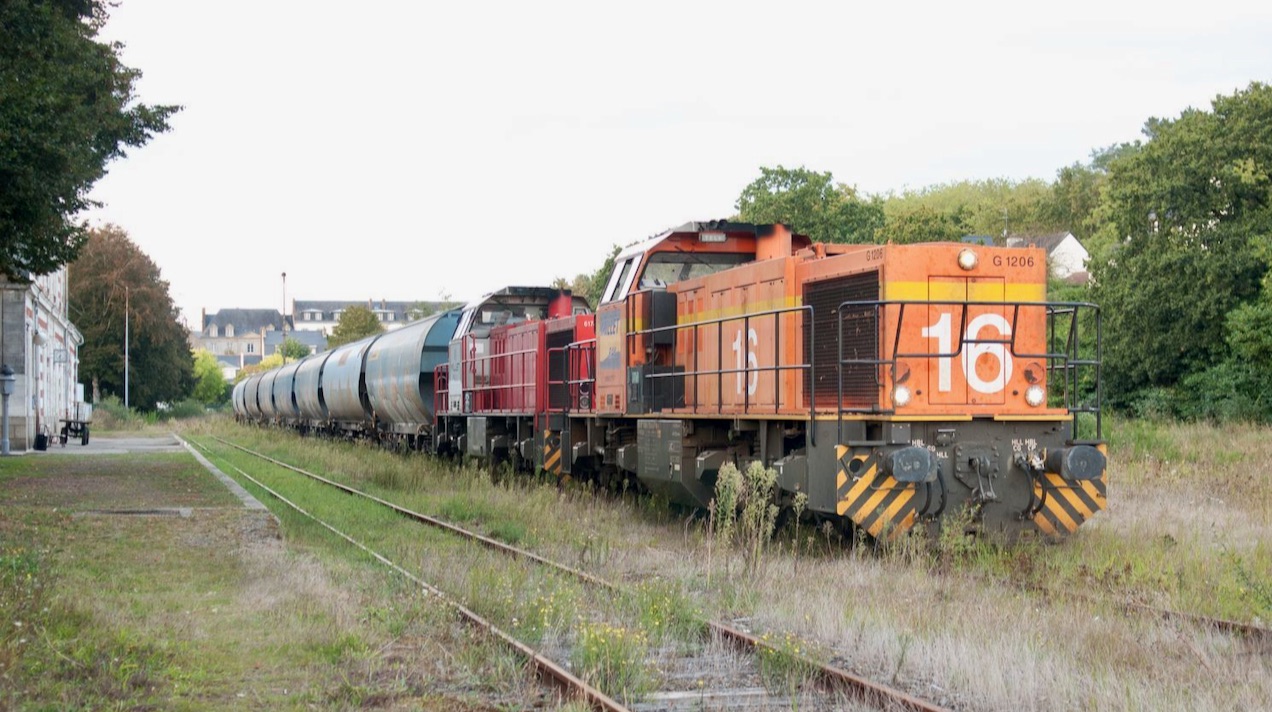
In recent years Millet Rail has become the major transporter of cereals in western France, utilising a fleet of Vossloh G1206s and hired-in ECR Class 66s. On 16th September former Colas 16 and former VFLI 61740 wait at Pontivy with cereals train No 407052 for Auray. Both locomotives still bear the liveries and numbers of their former operators. Photo: Michel Joindot.
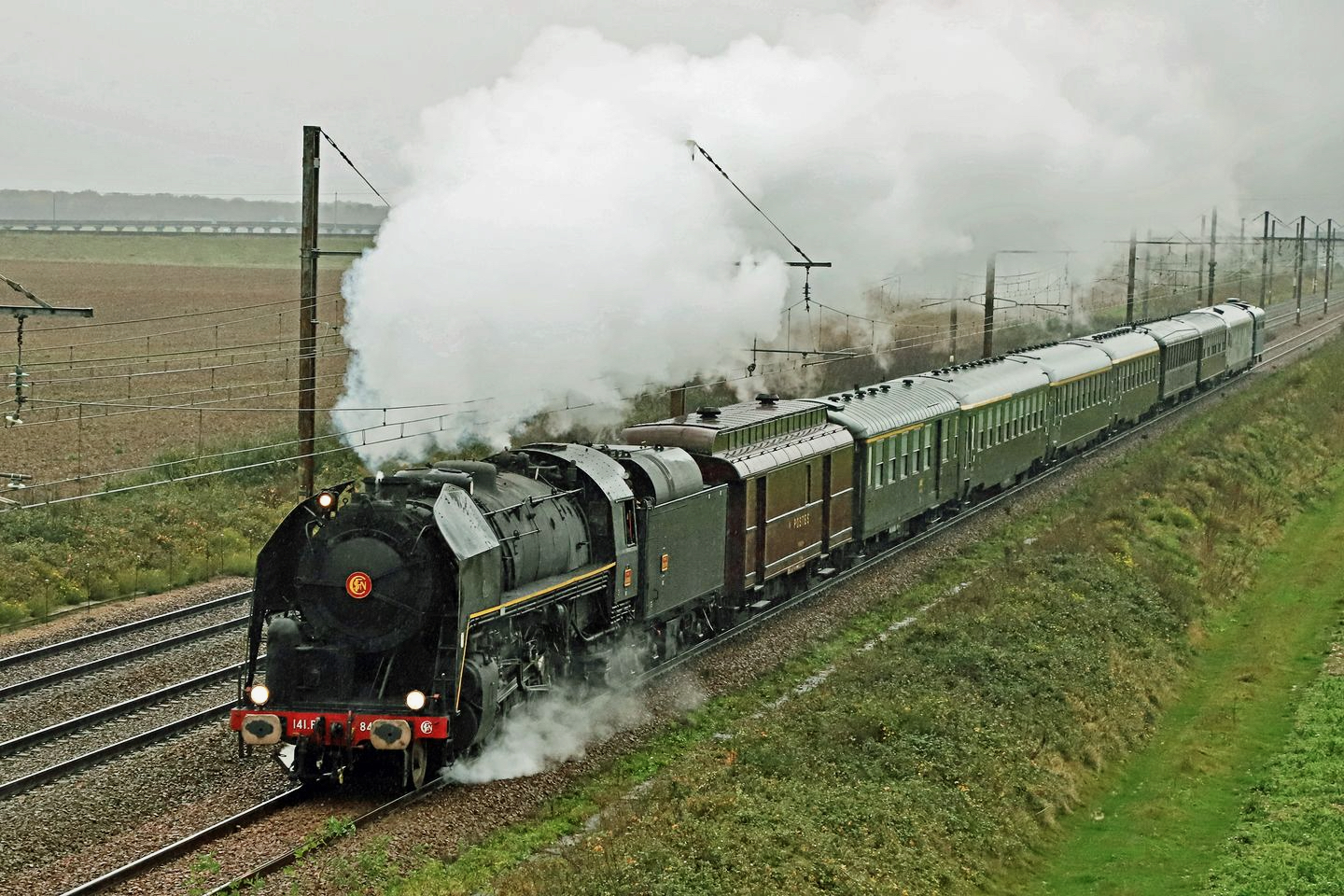
In typical November weather 141 R 840 is seen at Chevilly on Saturday 18th November heading towards Paris Austerlitz with an excursion from Les Aubrais. Photo: Jocelyne Bourneuf
Winter storms wreak havoc
Services started to resume on the afternoon of Friday 3rd November after safety checks had taken place, with 4,000 SNCF staff and 250 lumberjacks mobilised to clear more than 2,000 fallen trees, make 300 catenary repairs and restore signalling and power supplies. Paris – Hendaye TGVs were severely delayed on the 3rd by debris on the tracks, although most TGVs were running normally by Saturday 4th, except between Calais and Rang-de-Fliers where services did not restart until the 6th due to flooding.
Through services between Caen and Rennes were not restored until Wednesday 8th. In Normandie Lison – Cherbourg trains were restored on the 5th with single-line working. In Bretagne services between Morlaix and Brest and Lorient – Quimper did not begin again until the 6th, with Carhaix – Guingamp – Paimpol and Quimper – Brest remaining closed, the latter with 200 trees lying on the track. It was Saturday the 11th before services were back to normal on all lines. Along the Channel Coast, Hauts-de-France was particularly badly hit, Calais – Boulogne – Amiens services not resuming until the 5th with Etaples – Arras, St-Pol – Béthune, Beauvais – Le Tréport and Amiens – Tergnier – Laon routes not restarting until the 6th.
While services were beginning to be restored on Saturday 4th, Storm Domingos struck further south. The mid-day Paris – Cahors train slipped to a stand at Eguzon, north of Limoges, due to a massive fall of wet leaves. A second locomotive was despatched from Brive, and the two locomotives were able to continue after a delay of several hours with the train terminated at Brive to await the following Paris – Toulouse service. This had suffered a 5h delay at Châteauroux after hitting a tree at Luant. Then at about 02.00 on the 5th at Allassac, north of Brive, the train was hit by a second tree that fell between two carriages, damaging the locomotive pantograph as it fell. A rescue loco was again despatched from Brive, eventually bringing in the stricken train at 06.30.
With some 600 passengers being carried on the two trains, Protection Civile de la Corrèze was activated along with taxi drivers to provide refreshments and support. The passengers from both trains eventually left Brive at 08.30 on Sunday 5th with many having endured a journey of more than 18h. Services were still facing delays later that day with the 12.41 Paris – Toulouse noted departing from Brive 6h late.
No sooner had work on repairing the damage from Storm Ciarán got underway when on Wednesday 8th further heavy rain and widespread flooding affected northern France. Vast areas of the low lying land between the Somme estuary and the Canche Valley at Etaples were flooded halting services between Etaples and St-Pol sur Ternoise. Although this section of track was rebuilt in recent years SNCF do not anticipate it reopening until March 2024. Below left. Flooding near Montreuil-sur-Mer Photo: SNCF.
On the Calais – Amiens main line, water run-off caused damage in a cutting at Hardelot north of Etaples, blocking through traffic between Etaples and Boulogne. SNCF does not expect this section to reopen until February 2024 while a 300m-long retaining wall is built to prevent further slippage of the cuttings walls. Services are currently operating from Etaples to Amiens and Paris and from Boulogne to Calais and Lille (see below right). Photo: La Voix de Nord.
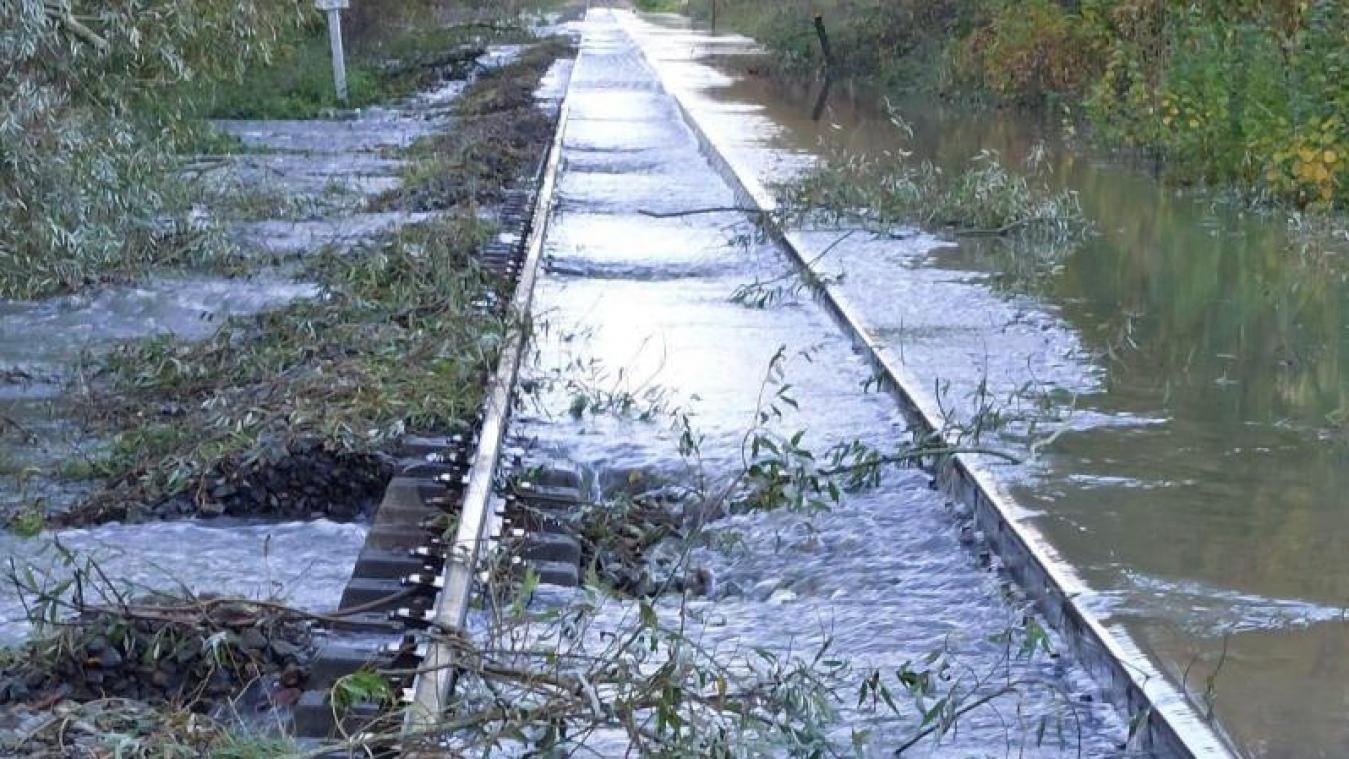
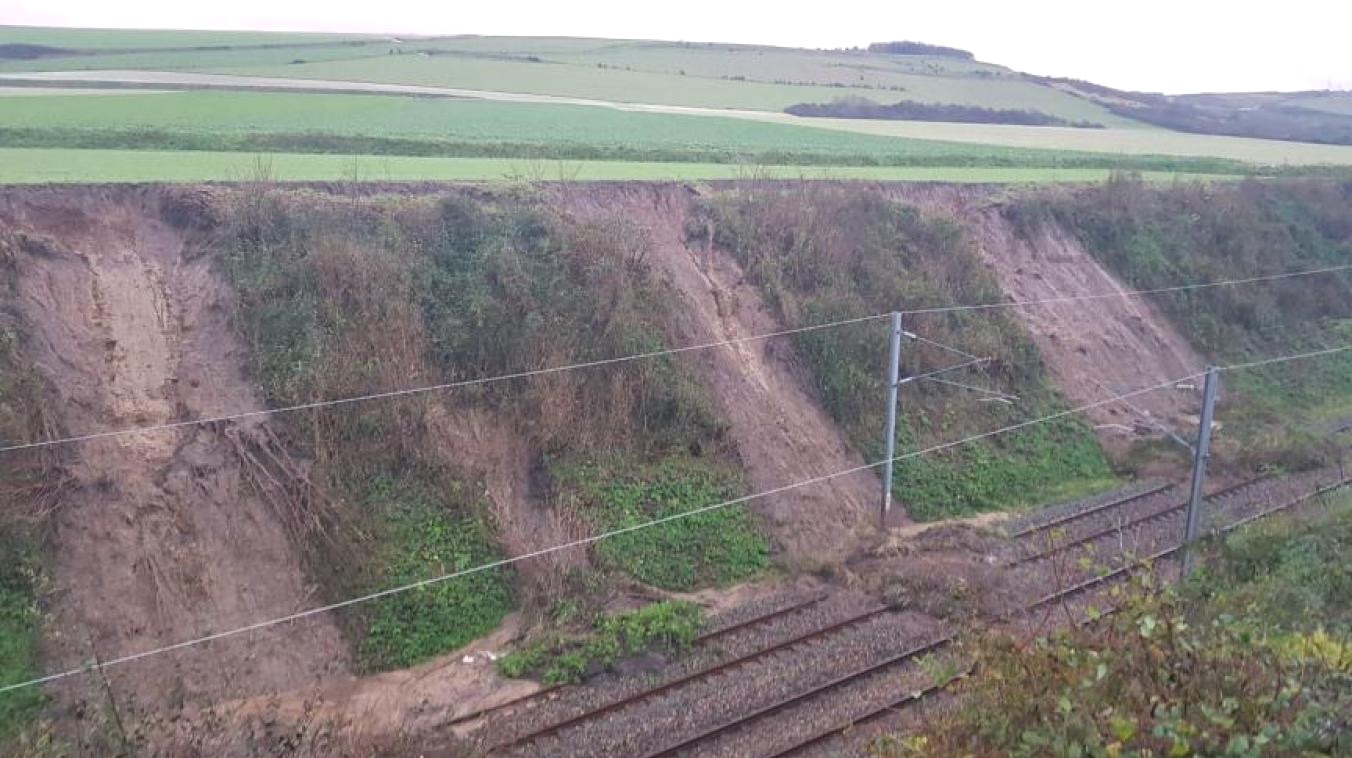
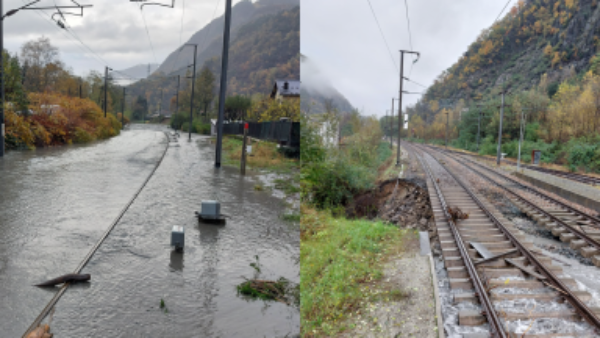
Storms on 14th November caused flooding and a washout at Notre-Dame-de-Briançon between Albertville and Bourg-Saint-Maurice. Rebuilding of the embankment and trackbed was hampered by continuing bad weather. The line is expected to reopen for freight on 8th December and to passengers on the 15th. Photos: SNCF Réseau.
On the 16th November, Storm Frédérico hit the Normandie coast before moving inland, causing a landslide at the entrance to Fécamp and closing the line between between Fécamp and Bréauté until the 21st November.
Storm Frédérico then swept across the Massif Central hitting Clermont-Ferrand with winds of up to 126km/h, causing trains on all lines to be disrupted and then cancelled for the rest of the day. Trams and buses were also halted. The 05.51 Aurillac – Clermont TER hit a fallen tree near Molompize. A second DMU was sent out from Neussargues to rescue the stricken train but the automatic couplers would not connect. Logging teams later cleared the track, enabling the railcar to run at low speed to the nearest level crossing where passengers were transferred to a bus. SNCF services were back to normal on the 17th except for some early-morning departures. Nine Clermont trams were damaged by flying debris.
Photo: La Montagne.
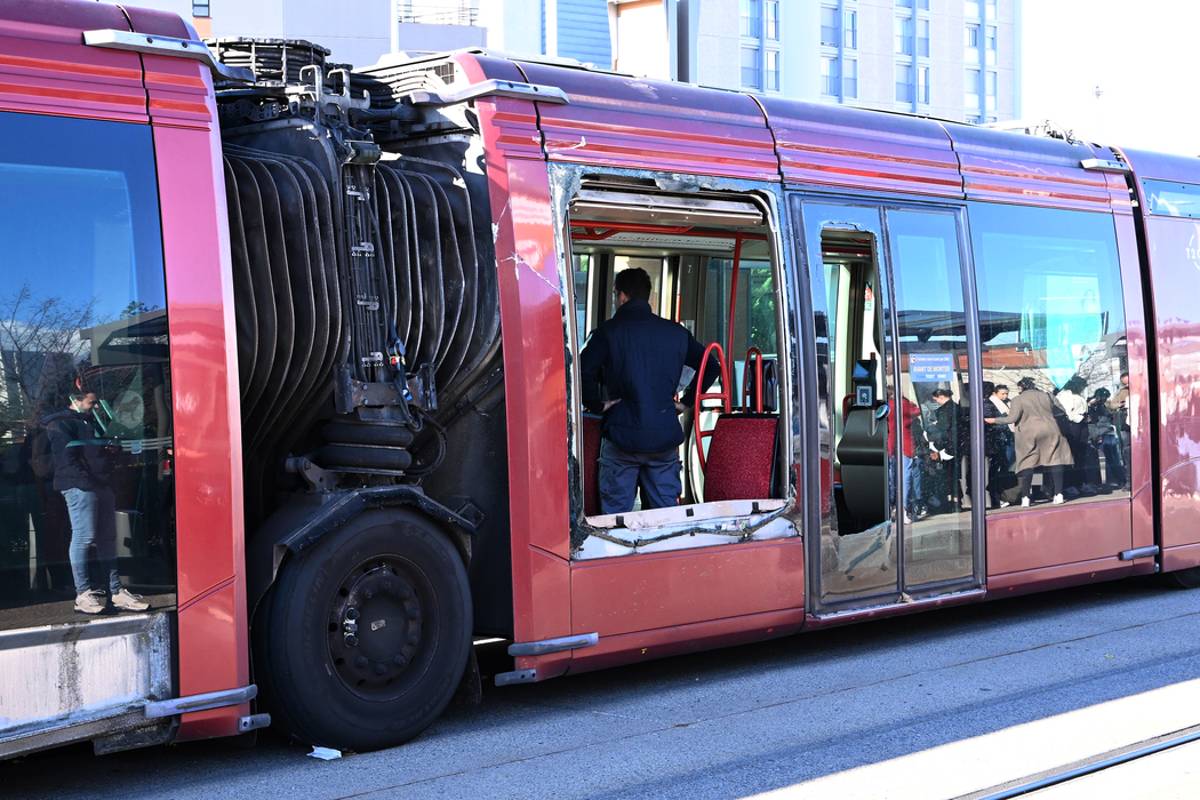
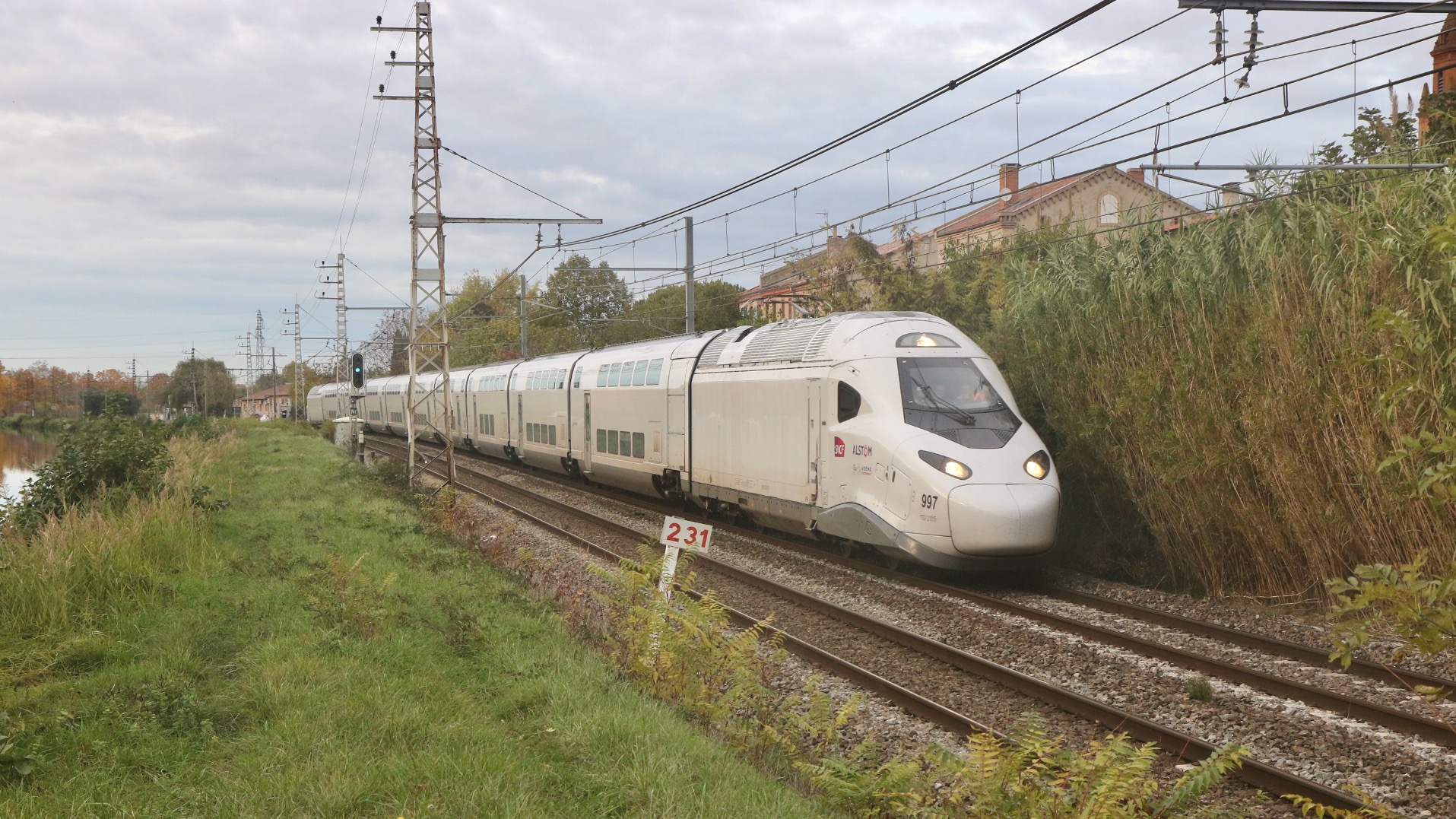
TGV M trials in Southwest
Prototype TGV M No 997 is seen on 13th November passing PK 231 where the railway runs alongside the Canal latéral de la Garonne at Pompignan between Montauban and Toulouse, running as Train 772901 Libourne – Narbonne. In the previous week it had been undergoing braking tests on the Capvern incline east of Tarbes. The first TGV Ms are expected to operate in the southeast, and it is unlikely that they will arrive in the southwest until after commissioning of the Bordeaux – Toulouse LGV in 2032. Therefore they will never pass here in regular service. Photo: Georges Turpin.
News in Brief
POLT cuts. More misery for POLT travellers comes in the form of suspension for two months from 29th January of the first two Up departures from Brive (03.57 and 04.58) and the last two evening trains from Paris (18.41 and 19.39) to allow more time for overnight engineering work. Earliest arrival in Paris will be 10.19. Overnight services will be diverted with no stops between Les Aubrais and Montauban. Representatives of départements served by POLT again voiced their frustrations over the line’s chronic reliability at a meeting with transport minister Clément Beaune on 16th October.
Saint-Etienne works. No trains ran into Saint-Etienne-Châteaucreux station between 3rd and 6th November while SNCF Réseau replaced 13 sets of points and associated track in the latest stage of an infrastructure modernisation projected costed at €6.5 million.
Saint-Jean-Pied-de-Port. Patronage of the line from Bayonne has recovered from the effects of strikes, covid, closures and cancellations, with a record 2,778 daily passengers in July, up 34% on last summer’s figures. The increase is accounted for by tourists and pilgrims; local travellers continue to be put off by the line’s poor reliability, though SNCF reports having sufficient drivers to run the full timetable from this month.
Bedous gloom. By contrast, neither tourists nor locals are flocking to the trains at Bedous, the daily average for 2022 being 45. However, patronage at Oloron-Saint-Marie and the new station at Bidos rose by 27% to 101,000. Reopening between Oloron and Bedous in 2016 was intended to open up the Aspe valley to tourists and reduce traffic on the narrow congested N134 road.
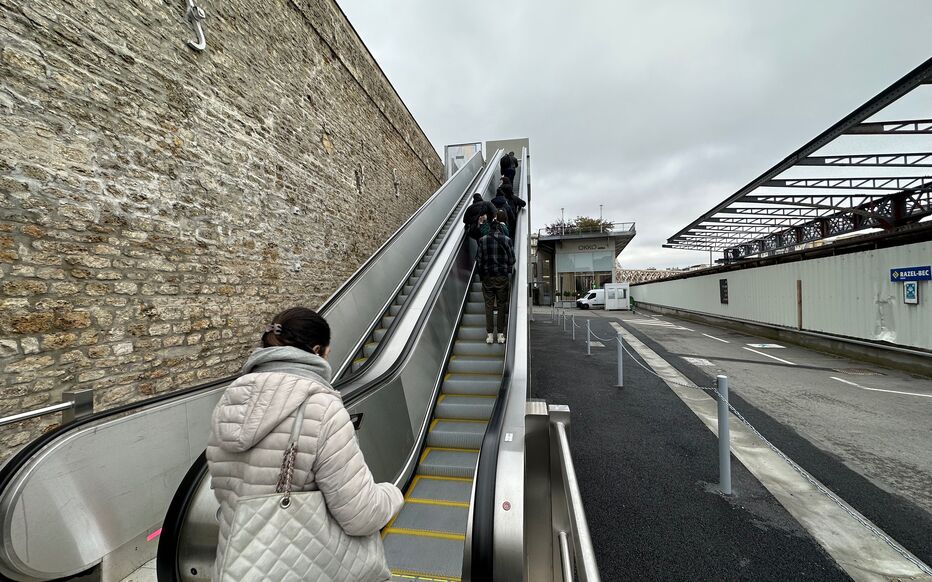
Paris Nord – Est link. A pair of escalators and a lift have been installed on the rue d’Alsace, easing the short but awkward pedestrian interchange between Gare du Nord and Gare de l’Est. These will be superseded in 2027 by an underground link, construction of which is expected to start next autumn after the Olympic Games. Photo: Le Parisien/Paul Abran.
Clermont weekends. Free weekend travel on public transport in Clermont-Ferrand, inaugurated in December 2021, is to continue until 2027. The policy has seen travel increase by 26% on Saturdays and 62% on Sundays, at a cost of €2.1 million in revenue foregone. About half of the additional journeys have been made by tram.
Pilgrim train agreement. The convention between the association of national diocesan officials and SNCF, Les Accords de Lourdes, has been renewed for a further three years. Signed on 6th November, the new accord covers running of between 60 and 70 pilgrim trains a year to Lourdes from 30 French dioceses. This is about half the number of trains in 2006 when the first Accord was agreed; more pilgrims now travel by coach, plus scarce station capacity makes it harder to accommodate trains requiring 2h dwell time for loading and unloading.
Niort – Saintes. Emergency repairs were carried out during October between Niort and Saintes (72km), where trains are limited to 60km/h due to the poor state of the track following periods of drought and heavy rain. A major upgrade of the permanent way, much of which dates from the 1960s, is planned for next year.
Pay offer. SNCF offered an average pay increase of 4.6% for 2024 at a meeting with trades union officials on 8th November. Designed to boost rail’s attractiveness at a time of severe staff shortage, all employees will receive an uplift of 1.8%, with more for the lowest pay grades. Job applications were up 37% this year but shortages persist in some areas and some disciplines.
Eurostar rivals. Hot on the heels of Evolyn (see last month’s News), two more groups are planning cross-Channel services. A report in The Daily Telegraph suggested that Sir Richard Branson is drafting plans ‘to go head-to-head’ with Eurostar in the cross-Channel high-speed rail market, without mentioning the rolling stock or security/customs issues that any new operator would face. Similarly, Dutch start-up Heuro is seeking approval from the country’s competition and markets authority to start services from Amsterdam to Paris and London in 2027, with stops at Schiphol airport, Rotterdam, Antwerp and Brussels. It proposes 16 Amsterdam – Paris and 15 Amsterdam – London daily trains.
Travelski seeks operator. With Eurostar running only limited winter ski trains on its own account, the Cie des Alpes is seeking a European railway operator to provide its Travelski services from London, Paris, Amsterdam and Brussels twice-weekly throughout the ski season for a three-year period 2024-26. Of the 2 million Dutch, Belgian and British who visit the Alps for winter sports, fewer than 4% travel by train.
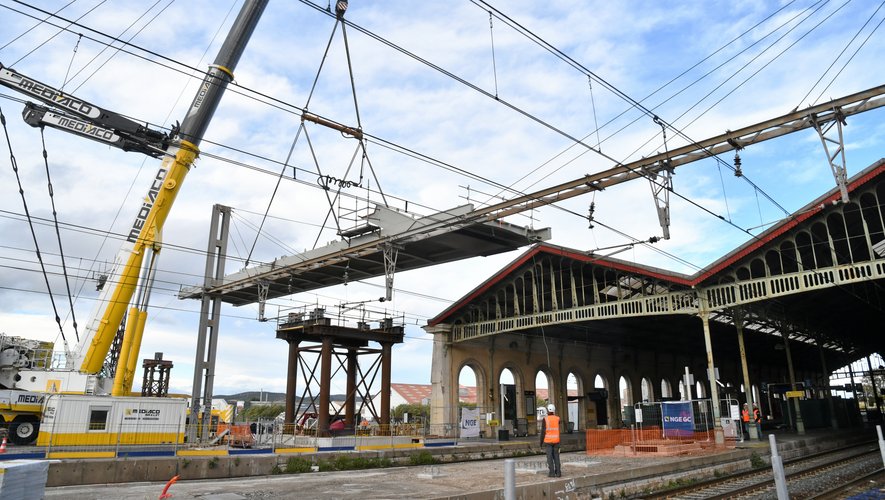
Sète footbridge. The first sections of a bowstring footbridge at Sète station were lifted into place on 3rd November. The 71m bridge will provide lift access to the platforms for persons with reduced mobility as well as linking the station forecourt with the multimodal interchange and other development planned for the north side of the tracks.Photo: Midi Libre/Nicolas Zarrouk and SNCF Gares et Connexions.
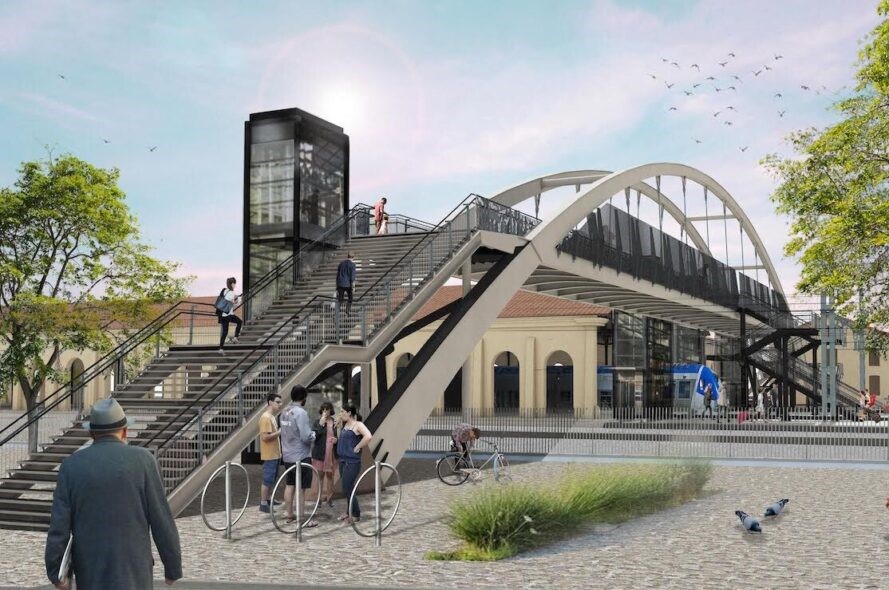
Pays de la Loire stations. A new four-year contract was signed on 24th October with SNCF Gares et Connexions envisaging investment of €65 million in accessibility works, development of multi-modal hubs, passenger comfort and information, and installation of photovoltaic panels on buildings and over parking areas. Several stations are to be adapted for ease of use by cyclists under the train+vélo scheme. The région is also considering purchase of up to 30 new trains in 2024-25.
Railpool France. Germany’s leading loco-leasing company is establishing Railpool France SAS with the aim of starting operations in mid-2025, coinciding with initial deliveries of Traxx locos from the order for 50 placed with Alstom at the beginning of the year. Railpool has secured its first (unnamed) French client.
AFNT inquiry. Public hearings were held during November to consider SNCF Réseau’s application for environmental approval prior to start of quadrupling between Toulouse Matabiau and Castelnau-d’Estrétefonds. This is the first construction stage of the Bordeaux – Toulouse LGV, known as Aménagements Ferroviaires au Nord de Toulouse (AFNT), on which work had been scheduled to start ‘by the end of the year’. SNCF presented its proposals for ‘avoiding, reducing and compensating for’ the effects of the widening on adjacent communes, their flora and fauna, protected species, local drainage systems, noise and nuisance mitigation, and new and existing infrastructure.
Another urban legend. A spate of internet articles citing a law of 1910 that forbids kissing on station platforms led Figaro Voyage to investigate. Neither SNCF nor the government’s legal department could find any restriction relating to les embrassades, though it is thought early railway regulations might have frowned on long farewells in the interest of good timekeeping. This myth recalls the furore created by spoof ‘No Kissing’ signs put up by Virgin Trains at Warrington in 2009.
Le Boulou expansion. Public consultation started on 1st December for SNCF Réseau’s proposed expansion of the freight terminal at Le Boulou south of Perpignan, aimed at removing a further 10,000 lorry trips per week in Pyrénées-Orientales. Two locations are being considered for four new sidings away from the present site which is hemmed in by the A9 autoroute and the town. Locals generally support the development, while continuing to complain about noise nuisance and light pollution from the existing facilities.
Bordeaux unlimited. A pass for all-modes travel in the Bordeaux metropolitan area was launched on 7th November. TBM+Trains adds 16 stations on the TER network to the monthly tram, bus, ferry and self-service cycle pass for a supplement of €10, that is €53.50 per month for adults.
Combronde Clermont depot. Logistics firm Combronde opened a new depot at Clermont-Ferrand on 9th November for their intermodal service to Fos-sur-Mer. The 10Ha site at La Combaude, formerly part of the Michelin complex, is close to an existing facility at Gerzat just to the north, whence trains run to Le Havre. Combirail operate the service with traction provided by Captrain.
Père Noël sellout. When Chemins de Fer du Centre Bretagne advertised its programme of Père Noël trains from Pontivy andLambel-Camors on the internet, they were pleasantly surprised when all 600 seats sold out in two hours
More Omneos for Rémi
Centre-Val de Loire région took delivery on 9th November of the last Omnéo Premium EMU from the order for 32 placed with Bombardier (now Alstom) in 2018 to replace loco-hauled stock on the Rémi Express services between Paris and Orléans/Tours/Bourges and Montargis/Nevers routes. The occasion was used to announce purchase of a further seven sets to be delivered from summer 2026 for the Paris – Etampes – Orléans stopping service at a cost of €145 million.
Growth in Rémi ridership has been boosted since the start of the school year by 20,000 youngsters taking advantage of free travel at weekends. To ease congestion, additional weekend trains are introduced with the new timetable starting on 11th December, along with extra Friday afternoon services.
Below left. Representatives of Centre-Val de Loire, SNCF and Alstom welcome the last of the new trains at Orléans on 9th November. Completion of the order was delayed by a year due to covid and other problems. Photo: Radio France/Patricia Pourrez.
Below left. Representatives of Centre-Val de Loire, SNCF and Alstom welcome the last of the new trains at Orléans on 9th November. Completion of the order was delayed by a year due to covid and other problems. Photo: Radio France/Patricia Pourrez.
Right. The publicity video issued by Centre-Val de Loire region.
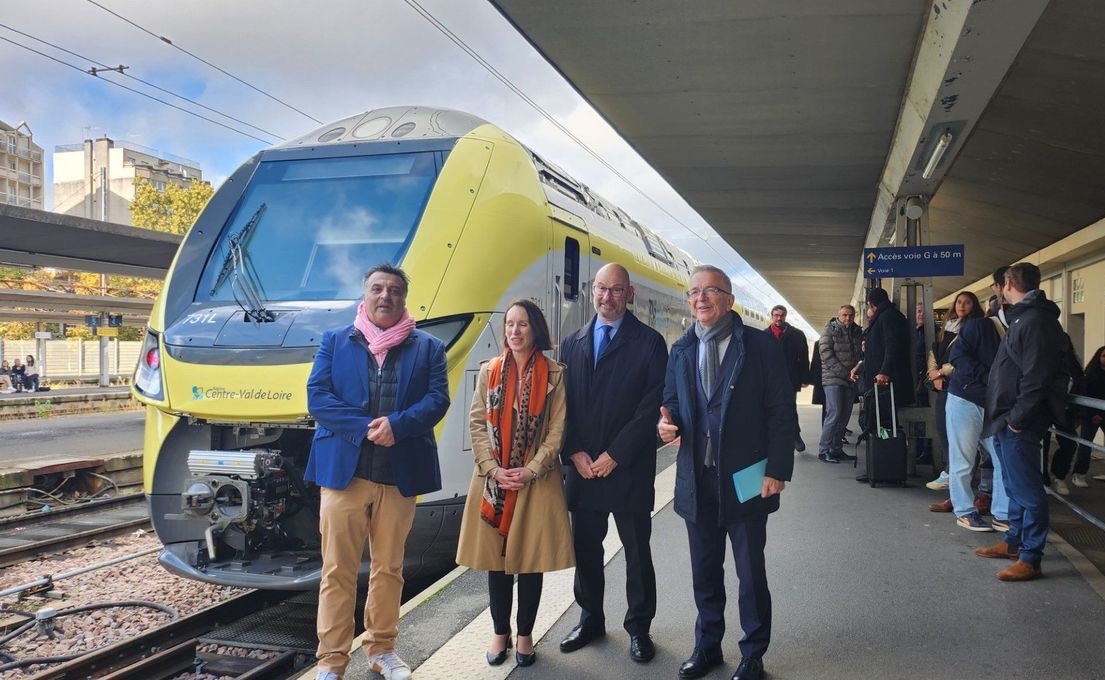
Direct Metz – Lyon service from 2025
Given its TET status, the service will presumably be operated by SNCF Voyageurs under the Intercités brand. The state will meet 50% of the operating deficit with the balance expected to be met by the communities en route. Rolling stock will be provided by the state, but as suitable stock is unlikely to be available by 2025 trains will initially be provided from the Grand Est fleet.
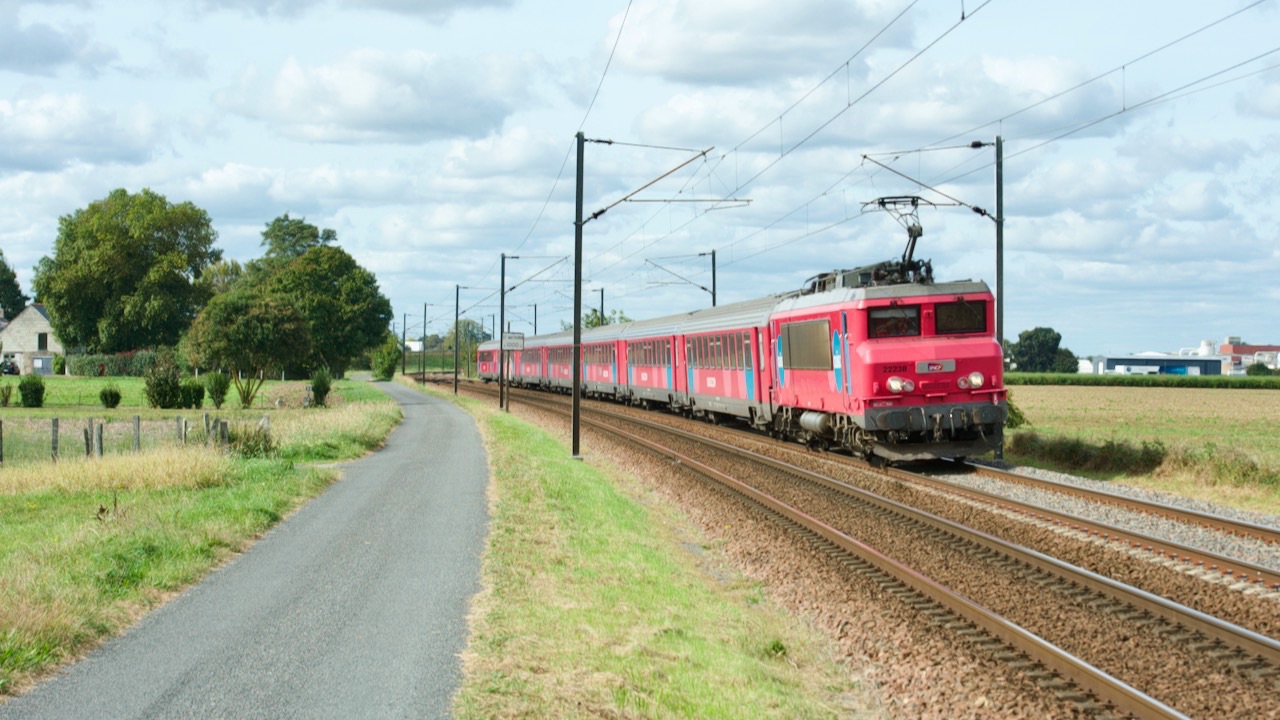
SNCF Voyageurs Ouigo Classique services meet two of SNCF's sustainability objectives: extending the life of 40-year-old rolling stock and offering affordable low cost travel. On 15th October 2023 BB 22238 has just passed Saint-Mathurin-sur-Loire with Train 4082 12.48 Nantes – Paris Austerlitz.
SNCF's sustainable balance sheet
SNCF’s Rapport de transition durable outlines progress made in 2022 in sustainability and corporate social responsibility (CSR), and sets out targets for achievement by 2030.
Sustainability progress includes alternative fuel developments (bio-fuel, battery, hydrogen, hybrid), responsible purchasing policies, life-extension of older rolling stock (for Ouigo Classic, Intercités and Trains de Nuit), recycling of components and rubbish, more electricity generated from renewable sources, and monitoring of driving practice to save energy.
Following on from development of the hybrid diesel-battery AGC, Alstom’s prototype AGC conversion from electro-diesel to battery-electric is now on trial (see following article). As well as demonstrating alternative fuel sources, these conversions make use of 20-year-old MUs which are re-equipped to run on electrified or non-electrified lines for a further 20 years.

Ease of accessibility at stations and onboard continues to improve for the 40% of passengers who have some kind of temporary or permanent reduction in mobility. TGV M is the first to be designed in collaboration with the Association d’Usagers en Fauteuil Roulant (Wheelchair Users Association) and promises 100% accessibility throughout the train. The train’s modular design will allow easy rearrangement of the interior layout to cope with future changes in passengers’ requirements. In 2022, the three Accès passenger-assistance services handled over 865,000 reservations; bookings can now be made up to 24h in advance instead of 48h. SNCF Connect and other websites and apps are gradually being brought into conformity with parameters set out by disabled-users associations.
There was a big rise in demand from passengers travelling with bicycles (train+vélo); 45% of TGV sets and almost all TER trains now have cycle space but future provision remains a problem as passenger capacity is so stretched. Staff were incentivised to cycle to work instead of driving by a grant of €150 towards purchase of a bicycle.
SNCF’s offer of travel at all levels of affordability was maintained despite inflationary pressures. Though operating costs rose by 13% it was possible to limit the 2023 TGV fares increase to 5%. The Ouigo low-cost offer was further expanded, while the régions achieved increased patronage of TER with attractive fares such as Occitanie’s weekend travel for €1.
More CSR effort was devolved to a local level, where small initiatives can bring big results and where staff can more easily act as ambassadors for rail. Funding for local initiatives, €5 million in 2022, has been doubled for 2023. Staff shortages continue to be a problem especially in deeply rural areas where train cancellations have been necessary on a day-to-day basis. Over 80% of staff undertook some sort of training during the year, of which 8,600 had training in CSR; 36.3% of personnel are female (up 2 percentage points) for whom the pay differential has narrowed to less than 5%.
CO2 emissions avoided by passengers choosing rail rather than other modes rose along with the increase in passenger-km, from 9.9 million to 13.4 million tonnes, while actual emissions per passenger-km declined from 9.1 to 7 grammes despite a 32% rise in train-km. Train travel creates five times fewer carbon emissions than the next best option, electric cars. Despite the incidence of more extreme weather due to climate change, minutes lost to weather events declined by 13% to 608,000.
Principal targets for 2030 are:
- Reduction of carbon emissions by 30% for traction and 50% for buildings (compared to 2015 figures).
- Doubling of passenger-journeys.
- 100% recycling of rubbish from trains and stations.
- Renewables to account for 50% of electricity consumption.
The full report can be seen at:

Mid-life extensions for AGCs and TER 2Ns
Introduced between 2004 and 2011 the 699 AGCs and 232 TER 2Ns make up 40% of the TER fleet and have now embarked on a mid-life overhaul programme. Contracted work by SNCF Voyageurs on behalf of the 12 régional TERs and Chemins de Fer Luxembourgeois currently amounts to €2.1 billion and is expected to reach €3 billion by the time the programme is completed in 2031. The work is being undertaken at seven Technicentres that have the capacity to deal with 55 units at a time.
While the majority of overhauls will be to existing mechanical specifications they provide an opportunity for the régions to update interiors with improved layouts and facilities such as power and USB sockets, and functions such as automatic passenger counting systems. For diesel powered AGCs there is an increasing drive towards reduced carbon emissions that is likely to see a move towards hybrid and battery conversion. As reported in May News, Grand-Est, Nouvelle-Aquitaine, Occitanie and Centre-Val de Loire Regions have collaborated on the creation of the first hybrid AGC where two of the four diesel engines have been replaced by lithium-ion batteries. This is expected to enter commercial service at the end of this year.
Alstom’s prototype AGC conversion from electro-diesel to battery-electric is on trial, having been unveiled on 18th October at the Rencontres Nationales du Transport Public in Clermont-Ferrand. All four diesel engines have been removed and replaced by eight lithium-ion batteries with an 800kW output, giving the prototype a range of 80km at speeds of up to 160km/h. The batteries can be re-charged when running under catenary or at station charging points. Five AGCs are being converted with the project sponsored by Alstom, SNCF and the Auvergne-Rhône-Alpes, Occitanie, Hauts-de-France, Provence-Alpes-Côte-d’Azur and Nouvelle-Aquitaine régions. Testing will continue into next year and it is planned to obtain passenger certification by December 2024. Once more information is available on operational performance and cost the régions will be in a position to determine the number of diesel equipped units (that make up nearly half of the AGC fleet) to be converted.
Photo: Michel Joindot.
Opposite. A Pays de la Loire Z24500 TER2N NG hurries along the Loire Valley with the 15.00 Tours – Nantes on 8th October 2022.
Opposite. A Pays de la Loire Z24500 TER2N NG hurries along the Loire Valley with the 15.00 Tours – Nantes on 8th October 2022.
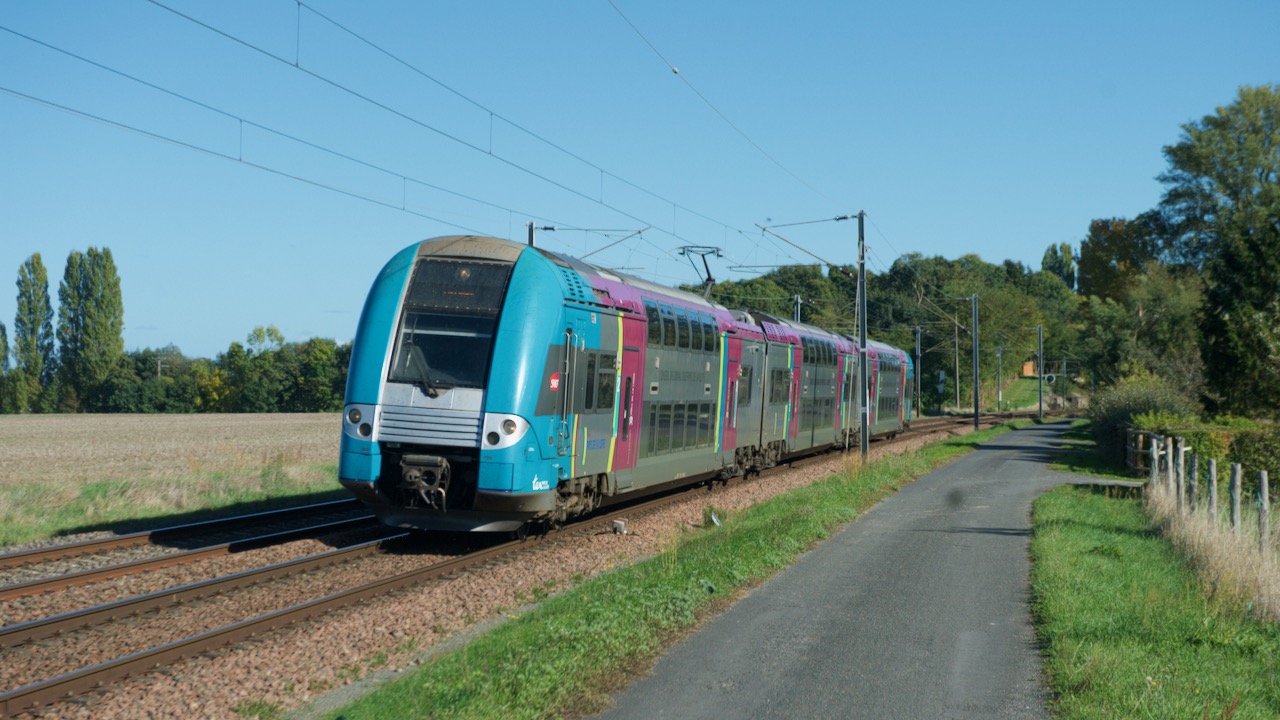
Grand Est investment
Grand Est région is to fund improvements on 14 rural routes and branch lines where little or no maintenance work has been carried out in recent years. The intention is to reduce the risk of speed restrictions or sudden closures due to degradation of infrastructure, reported to affect 75% of the région’s 840km network despite expenditure of €126 million since 2016. A new programme of work should start shortly, to be spread over the coming five years. The région is also providing €1 million for SNCF Réseau to accelerate a programme of lineside vegetation management on six routes. During 2022, around 100 TER services were cancelled and 228 delayed because of problems with falling trees and vegetation.
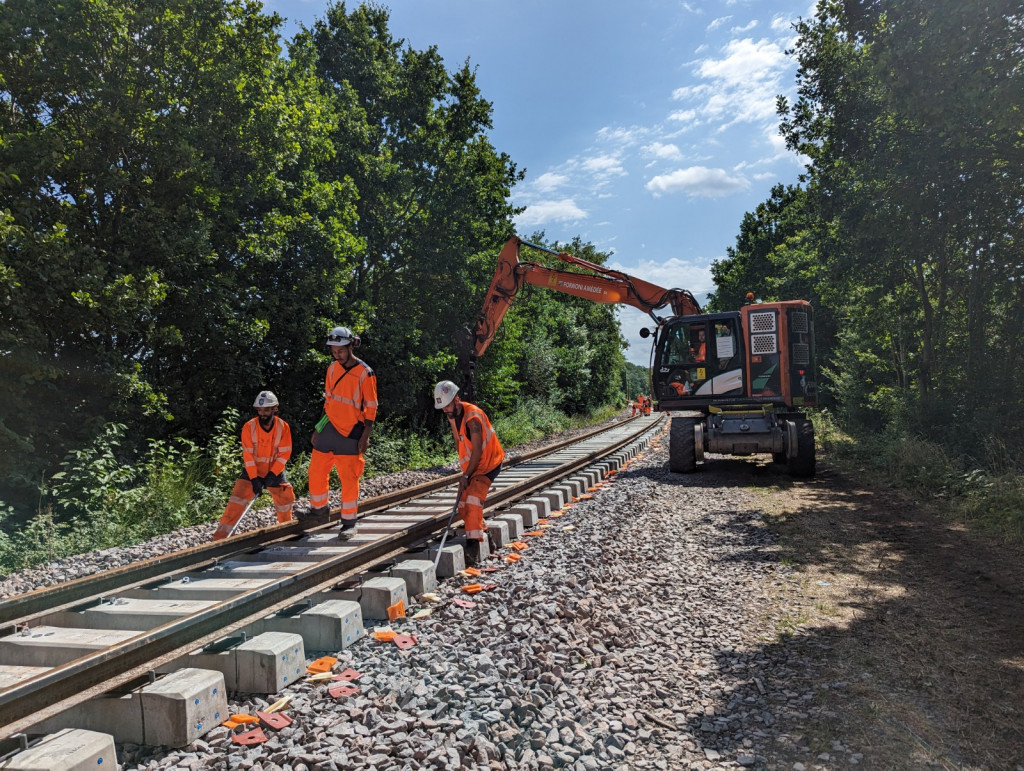
One current project is upgrading between Saint-Dié-des-Vosges and Saâles (25km) on the line from Strasbourg to Epinal, continuation of work undertaken intermittently since 2016. The first phase was carried out during a two-month closure over the summer holidays, replacing life-expired timber sleepers with concrete and renewing rail and ballast over a 3km section. Remedial work continued until 3rd November, with trains replaced by buses between Rothau and Epinal from 08.00 until 17.00. The cost of €5.3 million, 91.5% financed by the région, brings expenditure on this section to €26.3 million since 2018. Photo: Saint-Dié Info.
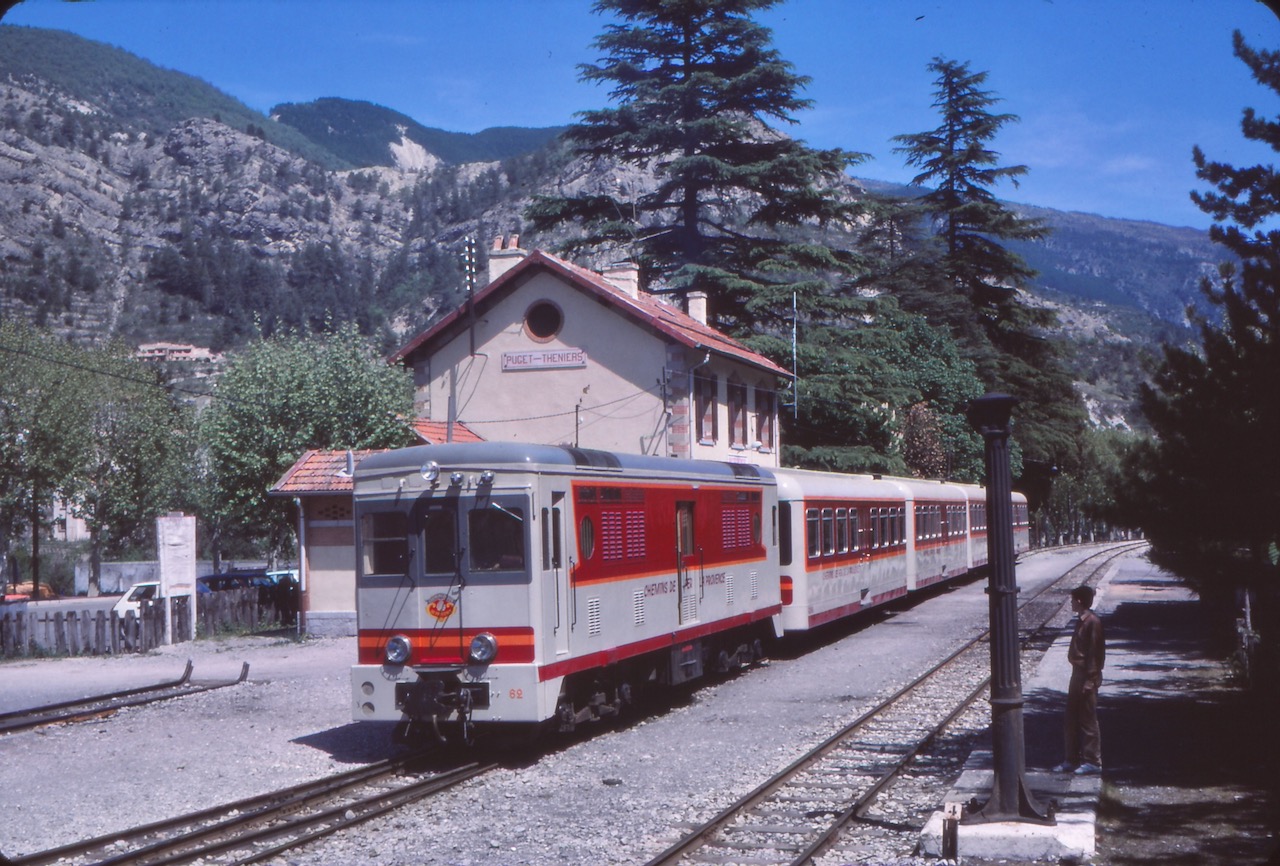
Brissonneau & Lotz T66 back in service
Recently overhauled and returned to service at the Vivarais is Brissonneau & Lotz T66, one of a series of 10 locomotives built by Brissonneau & Lotz in 1950-51 for Voies Ferrées du Dauphiné (4), Chemins de fer de Provence (4) and Corsica (2). They represented an important step for French metre-gauge railways. Previously many networks had built small diesel locos using steam loco frames and wheels but this was the first series of new diesels. Originally numbered T1, it ran on the VFD from Jarrie to Vizille until 1964, then remained parked at the VFD depot in Vizille-Terrace for some years. In April 1979 it was sold to Chemins de fer du Jura in Switzerland where it ran under the number Gm4/4 508 for track and overhead line work.
Twenty years later it was bought by CFTA, arriving in November 1999 at the Chemins de fer de Provence Lingostière depot where it joined T61-64 and became T66. Along with T62 it was adapted for push-pull working and operated on the CFTA until 2016.
T62 and T66 were then transferred to the Vivarais in exchange for parts from the CFD ex-Corse railcars Nos 2001, 2002 and 2005 that the Vivarais no longer needed. T66 arrived at Lamastre in October 2022 and operated its first test train in July 2023.
Above. T62 is seen on the CF de Provence at Puget-Theniers in May 1985. Opposite. Newly-restored T66 at Lamastre on 27th September.Photos: Georges Turpin.
Above. T62 is seen on the CF de Provence at Puget-Theniers in May 1985. Opposite. Newly-restored T66 at Lamastre on 27th September.Photos: Georges Turpin.
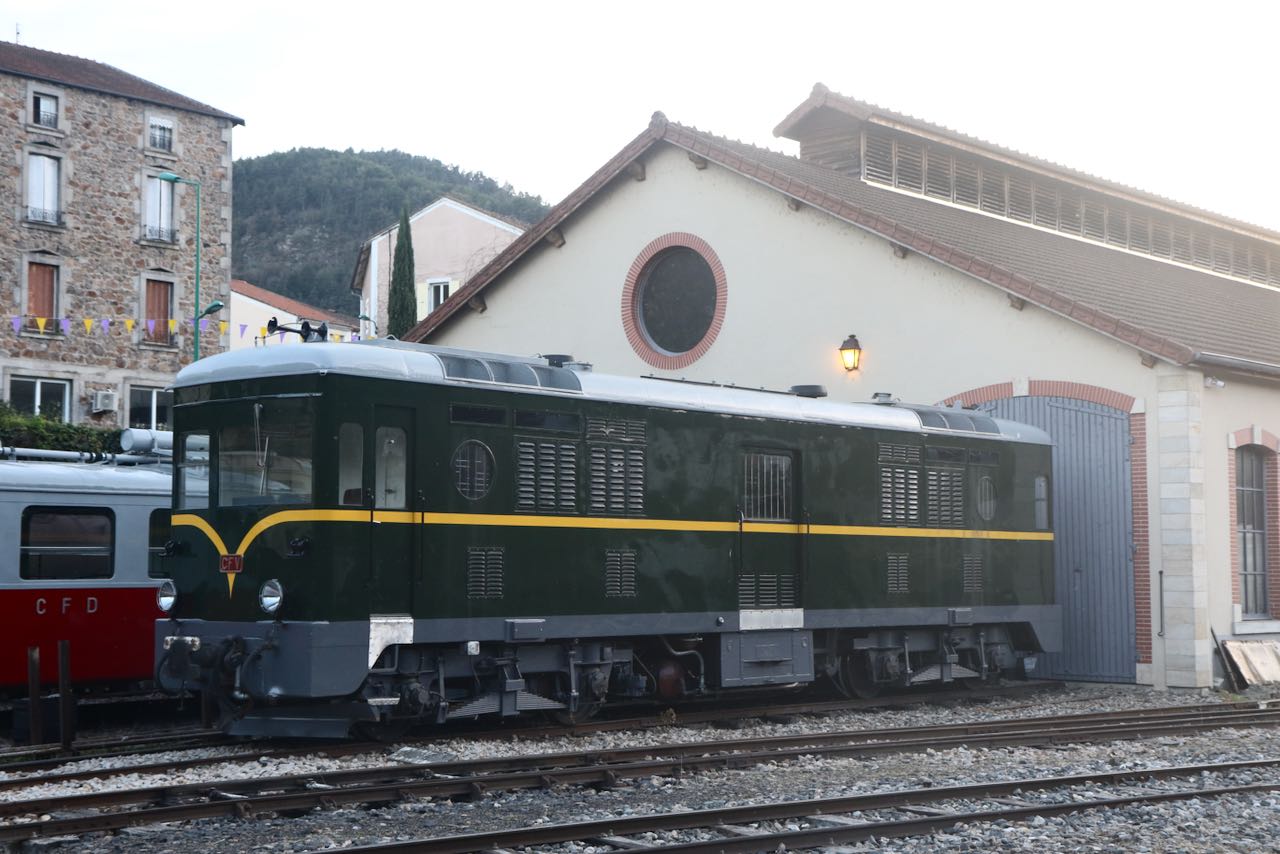
Urban Rail
Neomma trials start Marseille’s tramway and metro were busy with sporting crowds during October, hosting Rugby World Cup games and Europa League football. After the last match on 23rd October the metro was closed at 21.30 Monday to Thursday for running trials of the Neomma automated metro cars (see September News). Likely to last for two years, the early closing time was announced at short notice and provoked anger amongst passengers; online petitions garnered several thousand signatures.
Right. Neomma train ready for running trials.
Photo: Régie des Transports Métropolitains Marseille.
Marseille fares. Following trials last year, Aix-Marseille-Provence Métropole is rolling out contactless open payment across metro, tram and bus services in the agglomeration. Passengers can pay with contactless debit and credit cards, as well as NFC-enabled digital wallets.
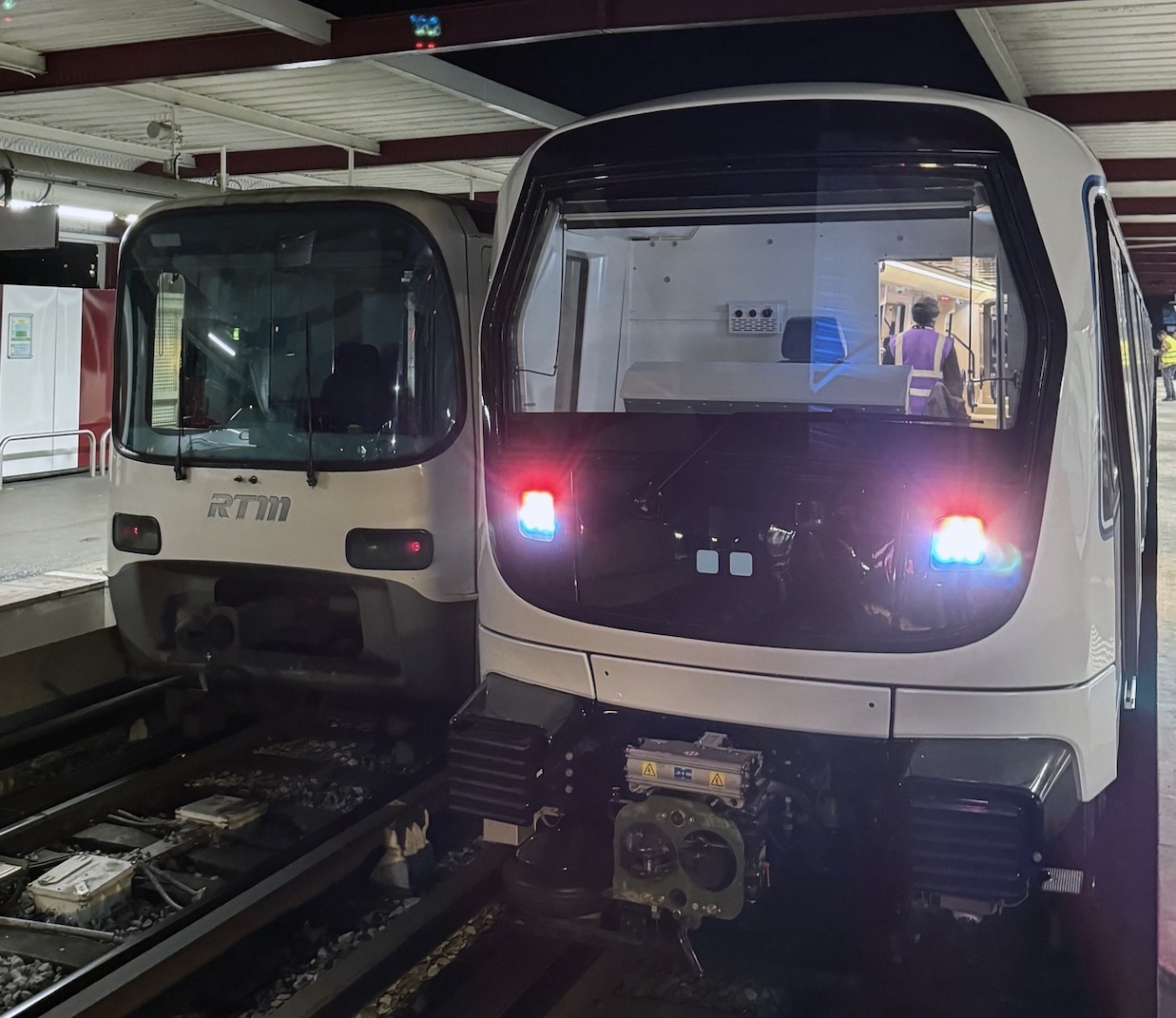
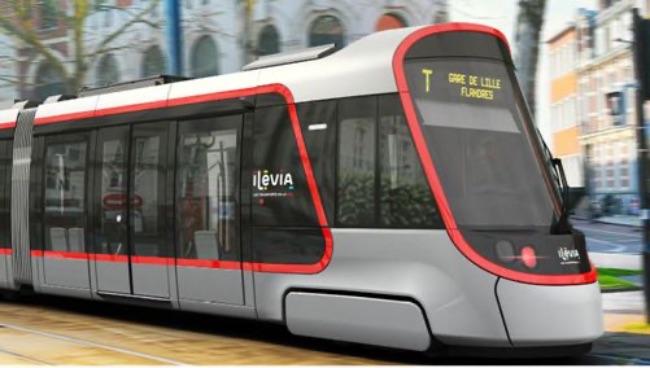
Lyon T10. Tram line T10 received its Déclaration d’Utilité Publique on 24th October. The 6.7 km line, scheduled to open in 2026, will provide an east-west connection across the south of the city from Halle Tony Garnier and Gerland on metro Line B to Vénissieux on Line D
Operator Keolis will need to deal with the tight transport jobs market in Lyon where around 500 places are on offer, including metro and tram drivers, and with Berthelet which runs the bus network in the eastern suburbs. As elsewhere, rail maintenance posts are proving particularly hard to fill.
Metro Line 4 automation. After seven years’ work at a cost of €489 million, by the end of the year Line 4 from Porte de Clignancourt to Bagneux-Lucie Aubrac will become the third line of the Paris metro network to be fully automated. Evening and weekend service has operated in automated mode since July. RATP expected to have the full complement of 52 trains available by mid-December.
Additions to FRS Photographic Archive during October/November 2023
To Photographic section
Additions to Folder 1
PS: Any additions to Folders 4, 7 & 11 (originating from Wikipedia & other sources) have COPYRIGHT RESTRICTIONS and are intended for personal enjoyment by members only
Additions to Folder 1
- Colour images added to the David Thirlwall gallery in Folder 1
PS: Any additions to Folders 4, 7 & 11 (originating from Wikipedia & other sources) have COPYRIGHT RESTRICTIONS and are intended for personal enjoyment by members only
To Locations section
Additions to the FRS public folder during October/November 2023
- Seven LVDR articles added
Additions to the FRS public folder during October/November 2023
- New category with indexes for photographic images and postcards depicting French railways
© Peter Lovell & Chris Bushell. The French Railways Society 2023. With thanks to Georges Turpin, Christophe Masse, Jocelyne Bourneuf, and Michel Joindot.
